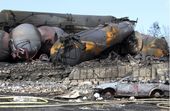Disaster_Accident
Latest Stories

cb3a15ff448fc40c4f0f6a7067005377.jpg
FEMA wooers head out of the site of a deadly mudslide, Friday, March 28, 2014, in Oso, Wash. Besides the 26 bodies already found, dozens more people could be buried in the debris pile left from the mudslide nearly one week ago. (AP Photo/Lindsey Wasson, Pool)

61e0e1164495c40c4f0f6a706700afb7.jpg
Workers comb through debris at the site of a deadly mudslide, Friday, March 28, 2014, in Oso, Wash. Besides the 26 bodies already found, dozens more people could be buried in the debris pile left from the mudslide nearly one week ago. (AP Photo/Lindsey Wasson, Pool)

fa818af54452c20c4f0f6a706700e720.jpg
This July 8, 2013 file photo provided by Surete du Quebec via the Canadian Press, shows wrecked oil tankers and debris from a runaway train in Lac-Megantic, Quebec, Canada. U.S. transportation officials say the oil industry is not giving up needed information needed to gauge the danger of moving crude by rail. Several oil train accidents, including one in Quebec, have highlighted the explosive properties of crude coming from booming oil shale fields on the Northern Plains. (AP Photo/Surete du Quebec, via The Canadian Press, file)


